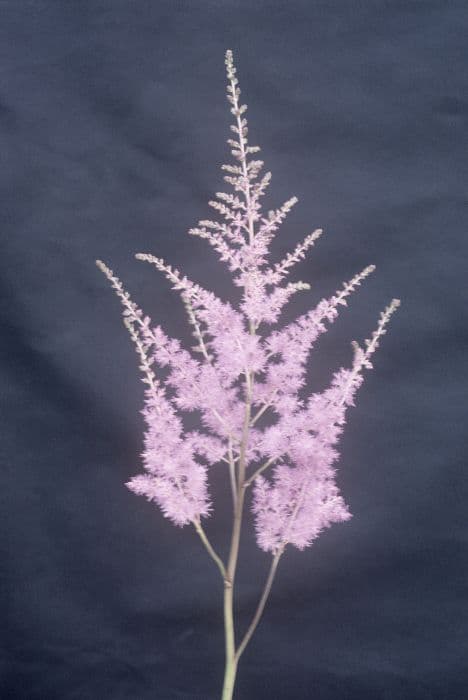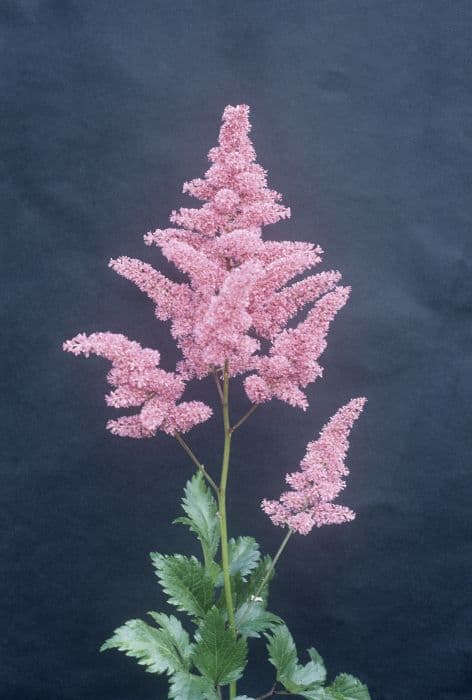Pigsqueak Bergenia 'Schneekoenigin'

ABOUT
Bergenia 'Scheneekoenigin', commonly known as Snow Queen, is a perennial plant that is noted for its striking appearance throughout the year. It has a rosette of leathery, dark green leaves that are evergreen, maintaining their vibrant appearance even in winter. During the colder months, the foliage sometimes takes on a red or bronze tinge, adding to its visual interest. The Snow Queen blooms in early to mid-spring, producing clusters of bell-shaped flowers atop stout stalks that rise above the foliage. The flowers are typically white or pale pink, giving an impression of snowflakes and thus complementing the name of the plant. These blossoms attract various pollinators, adding a buzz of activity to the serene beauty of the plant. As a garden specimen, Snow Queen is appreciated for its low-maintenance nature and the full, lush look it brings to landscapes. It thrives in moist, well-drained soil and can do well in a range of situations, from shaded areas to spots with more sunlight. The overall shape of the plant is rounded and it forms a clump, which can be used effectively in borders, rock gardens, or as ground cover. The sturdy nature of the plant allows it to be a resilient addition to many garden settings, and its contrasting foliage and flowers bring a notable element of color and texture.
About this plant
 Names
NamesFamily
Saxifragaceae
Synonyms
Snow Queen Bergenia, Winter Blooming Bergenia
Common names
Bergenia 'Schneekoenigin'.
 Toxicity
ToxicityTo humans
The Bergenia 'Schneekoenigin', commonly known as Pigsqueak, is not considered highly toxic to humans. There is limited information on the toxicity of this specific cultivar to humans, but generally, Bergenias are not known for being dangerous. However, ingesting any part of the plant may cause discomfort or irritation, and as with many plants, sensitive individuals may have an allergic reaction. It's always prudent to keep plants out of the reach of small children who might be tempted to eat them.
To pets
The Bergenia 'Schneekoenigin', commonly known as Pigsqueak, is considered to have a low level of toxicity to pets. While it is not commonly reported to cause serious illness, ingestion of any part of the plant could potentially result in mild gastrointestinal upset, such as vomiting or diarrhea, especially in pets with sensitive stomachs. It is advisable to monitor your pet if it has ingested this plant and to consult with a veterinarian if any concerning symptoms develop.
 Characteristics
CharacteristicsLife cycle
Perennials
Foliage type
Evergreen
Color of leaves
Green
Flower color
White
Height
1-2 feet (30-60 cm)
Spread
1-2 feet (30-60 cm)
Plant type
Herb
Hardiness zones
3
Native area
Asia
Benefits
 General Benefits
General Benefits- Easy to grow: Bergenia 'Schneekoenigin' is a low-maintenance plant that can thrive in a variety of conditions, making it an excellent choice for novice gardeners.
- Drought tolerance: Once established, it has a good tolerance for drought, reducing the need for frequent watering.
- Year-round interest: This plant offers visual interest throughout the year with its evergreen leaves and seasonal blooms.
- Attracts wildlife: The flowers provide nectar in the spring, which can attract bees and other pollinators to the garden.
- Groundcover: Its dense growth habit makes it an effective groundcover, helping to suppress weeds and reduce soil erosion.
- Tolerance of different soils: Bergenia 'Schneekoenigin' can adapt to a range of soil types, though it prefers well-drained soils.
- Shade tolerance: It can grow in full sun to partial shade, offering flexibility in garden design and placement.
- Cold hardy: It is tolerant of cold temperatures, making it suitable for gardens in cooler climates.
- Low fertilizer needs: This plant does not require heavy fertilization, making it a low-impact addition to sustainable gardens.
 Medical Properties
Medical Properties- Anti-inflammatory: Bergenia 'Schneekoenigin' may contain compounds that can help reduce inflammation.
- Antimicrobial: The plant might have antimicrobial properties, which could help in fighting certain infections.
- Diuretic effect: It has been suggested that this plant can have diuretic properties, helping to promote the production of urine.
- Astringent: The plant's astringent qualities might be useful in tightening tissues and reducing secretions.
- Expectorant: Bergenia 'Schneekoenigin' has been traditionally used to aid in expelling phlegm from the lungs.
 Air-purifying Qualities
Air-purifying QualitiesThis plant is not specifically known for air purifying qualities.
 Other Uses
Other Uses- Bergenia leaves can be used to create a natural dye for textiles, providing a range of colors from green to brown depending on the mordant used.
- The large leaves of the plant are sometimes used in floral arrangements as a lush, green backdrop that accentuates the colors of other flowers.
- In some cultures, the leaves are used as natural disposable plates or wrappers for food, being both sizable and sturdy.
- The plant can be incorporated into a sensory garden due to its thick, leathery leaves which provide an interesting tactile experience.
- Bergenia's robust evergreen leaves can be utilized in garden art projects, such as creating leaf castings for decorative purposes.
- Leaf litter from Bergenia can be added to compost heaps as a source of organic matter that decomposes over time, adding nutrients to the compost.
- The Bergenia’s ability to grow in shadier areas can be harnessed to create living mulch under trees and shrubs, helping to conserve soil moisture and suppress weeds.
- The plant can be used as a natural border or edging in gardens, with its thick foliage serving as a low, dense barrier.
- Some gardeners use Bergenia as a living indicator of soil pH; the color of the flowers can sometimes vary slightly in response to the soil conditions.
- In frost-prone areas, Bergenia may be planted as an evergreen ground cover to protect against soil erosion during the winter months.
Interesting Facts
 Feng Shui
Feng ShuiThe Bergenia is not used in Feng Shui practice.
 Zodiac Sign Compitability
Zodiac Sign CompitabilityThe Bergenia is not used in astrology practice.
 Plant Symbolism
Plant Symbolism- Endurance: Bergenia, also known as 'Pigsqueak', is a plant that can withstand challenging conditions. Its leathery leaves and robust nature symbolize the ability to endure and maintain vitality through adversity.
- Tenacity: With its evergreen foliage, Pigsqueak is emblematic of tenacity, as it clings to life throughout the seasons, representing a person's steadfastness and determination to persevere.
- Protection: The thick, waxy leaves of the Pigsqueak suggest a protective quality, symbolizing a shield against harm and a safeguarding presence in one's garden and life.
 Water
WaterFor the Bergenia 'Schneekoenigin', commonly known as Queen of the Snow Bergenia, moderate watering is essential. It should be watered thoroughly when the top inch of soil feels dry to the touch, which can be about once a week, depending on environmental conditions. Provide enough water to moisten the soil throughout the root zone, which may amount to about 1-2 gallons for mature plants in garden settings. During the winter months or in cooler climates, reduce the frequency of watering since the plant will require less moisture. Ensure good drainage to prevent waterlogging, as Bergenia does not like to sit in overly wet soil.
 Light
LightThe Queen of the Snow Bergenia thrives best in partial shade to filtered sunlight. It can tolerate full sun in cooler climates but may need protection from the harsh afternoon sun in hotter regions. The ideal spot for the plant would be an area that receives morning sunlight and shade during the intense afternoon heat to prevent leaf scorch.
 Temperature
TemperatureQueen of the Snow Bergenia prefers a temperature range between 60°F and 75°F for optimal growth. It's a hardy plant that can withstand minimum temperatures down to around 0°F but should be protected from prolonged frost. Providing a mulch layer can help moderate soil temperature and protect the roots during extreme cold.
 Pruning
PruningPruning the Queen of the Snow Bergenia is generally done to remove spent flower stalks and damaged or dead foliage. Pruning can be performed after flowering or in early spring to tidy up the plant and encourage new growth. This helps maintain the plant's shape and vigor and is typically done once a year, preferably at the end of the blooming period.
 Cleaning
CleaningAs needed
 Soil
SoilElephant's Ears thrive in a soil mix consisting of equal parts organic matter, like compost or peat, mixed with perlite or sand to ensure good drainage. A slightly acidic to neutral pH range of 6.0 to 7.0 is ideal for this plant.
 Repotting
RepottingElephant's Ears should be repotted every 2 to 3 years to refresh the soil and provide a little more room for root growth. Choose a pot that is just one size larger.
 Humidity & Misting
Humidity & MistingElephant's Ears prefer moderate to high humidity levels but can tolerate lower humidity without significant problems as long as they are not subjected to dry heated indoor air.
 Suitable locations
Suitable locationsIndoor
Place in bright, indirect light, and keep consistently moist.
Outdoor
Select a shady spot with rich, well-draining soil and shelter from strong winds.
Hardiness zone
3-8 USDA
 Life cycle
Life cycleThe Bergenia 'Schneekoenigin', also known as Winter Queen Bergenia, begins its life cycle when a seed germinates, typically in the spring. The seedling emerges and develops into a rosette of rounded, leathery leaves that persist through the seasons. In its second or third year, it reaches maturity and produces tall flower spikes adorned with clusters of pink or white blooms in early to mid-spring. After flowering, the plant sets seed, which if not deadheaded, can self-sow in favorable conditions. Throughout the growing season, the Winter Queen Bergenia continues to produce new leaves, and the plant gradually forms a clump that can be divided every few years to propagate new plants. In winter, the foliage may take on a bronze-purple tone, providing year-round interest until the cycle begins anew with the next spring's growth.
 Propogation
PropogationPropogation time
Spring-Early Summer
The Bergenia 'Schneekoenigin', commonly known as Queen of the Snow Bergenia, is typically propagated by division. The optimal time for this method is either in the spring after the last frost has passed or in the early fall when the temperatures have cooled. To propagate by division, the entire plant is dug up and the clumps are carefully separated, ensuring that each new section has a portion of the roots intact. These divisions are then planted into their new locations at the same soil depth they were originally growing. It is important to water the new plants thoroughly after planting to help establish them. This method allows gardeners to quickly multiply their Bergenia plants and is well-suited to this species' growth habit.









